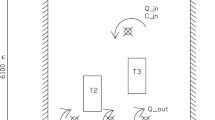Abstract
In this paper, the Sentinel method is applied to groundwater pollution parameter identification. First, the inverse problem is solved in the linear case to estimate pollutant mass flow rates. Then, the non-linear case, which is the determination of the pollutant source coordinates, is developed. Finally, numerical tests, conducted on the Rhenan aquifer, south of Strasbourg, are presented.
Similar content being viewed by others
References
D. Acheli, Application de la méthode des sentinelles à quelques problème inverses, Ph.D. dissertation, Université Technologique de Compiègne, France (1997).
E. Chardigny, Etalonnage d'un modèle hydrodynamique régional par approche inverse. Application à la modélisation de l'hydrodynamique de la nappe d'Alsace, D.E.A., Université Louis Pasteur Strasbourg, France (1995).
G. Chavent, Generalized sentinels defined via least squares, Rapport de Recherche de l'INRIA No. 1932 (1993) 32 pp.
J.P. Kernévez, The Sentinel Method and its Application to Environmental Pollution Problems (CRC Press, Boca Raton, FL, 1997).
W. Kinzelbach, Groundwater Modelling-An Introduction with Sample Programs in Basic, in Developments in Water Science (Elsevier, Amsterdam, 1986).
J.-L. Lions, Sur les sentinelles des systèmes distribués, CRAS, Tome 307 (Paris, 1988).
F. Molinet, Simulation numérique de problèmes d'écosystèmes. Sentinelles pour la détection de l'origine d'une pollution, Ph.D. dissertation, Université Paris XI, Orsay, France (1994).
C. Poulard, Application de la méthode des sentinelles à la détermination de paramètres de transport en milieu poreux, Ph.D. dissertation, Université Louis Pasteur, Strasbourg, France (1997).
F. Schwille, Dense Chlorinated Solvents in Porous and Fractured Media-Model Experiments (Lewis, Chelsea, 1988).
T.H. Skaggs and Z.J. Kabala, Recovering the history of a groundwater contaminant plume: method of quasi-reversibility, Water Resour. Res. 31(11) (1995) 2669–2673.
P. Siegel, Transfert de masse en milieu poreux fortement hétérogènes: modélisation et estimation de paramètres par éléments finis mixtes hybrides et discontinus, Ph.D. dissertation, 184 pp., Université Louis Pasteur, Strasbourg, France (1995).
P. Siegel, R. Mosé, P. Ackerer and J. Jaffre, Solution of advection-diffusion equation using a combinaison of discontinuous and mixed finite elements, Internat. J. Numer. Methods Fluids 24 (1997) 1–19.
N.-Z. Sun, Inverse Problems in Groundwater Modeling, Theory and Applications of Transport in Porous Media (Kluwer Academic, Dordrecht, 1994).
Author information
Authors and Affiliations
Rights and permissions
About this article
Cite this article
Mosé, R., Stoeckel, M., Poulard, C. et al. Transport parameters identification: application of the Sentinel method. Computational Geosciences 4, 251–273 (2000). https://doi.org/10.1023/A:1011516101288
Issue Date:
DOI: https://doi.org/10.1023/A:1011516101288




